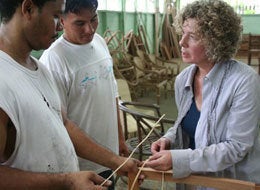
Hands up if you've ever bought a handicraft while traveling, only to have it end up collecting dust in some closet at home.
Thought so.
We've all been there. Our hearts are in the right place: crafts are an important source of income for people in developing countries. And buying them helps ensure that traditional skills continue to be passed from generation to generation.
Still, isn't it just more stuff we don't really need?
Patty Johnson asked herself if there wasn't another way. And the North South Project is her answer. In a nutshell, it brings indigenous expertise and northern design and marketing skills together to create new products that people want to buy. And will actually use.
North South started small, with projects in two countries. Guyana came first: Patty worked with Jocelyn Dow who was, "doing great things with a vine that grows in the rainforest, a sustainable alternative to traditional caning." Then, a furniture maker in Botswana caught wind of what they were doing, and teamed up with North South.
The first North South Project products - notably a modern variation on the Windsor chair, and a spectacular lighting fixture - were launched in 2006, at the International Contemporary Furniture Fair in New York, to huge acclaim. Today, North South is furiously expanding in all directions.
In new countries, like Mexico. "We've been working on a ceramics project in Guanajuato, a historically important ceramics area," Patty told me when we spoke earlier this week. "The first of the line was launched earlier this year at the International Gift Fair in New York, and the Interior Design Show in Toronto." North South is also working in regions such as the Caribbean. For the last year, Patty has worked with seven companies from Haiti, Jamaica, Dominique, and Barbados. "The Onsite Caribbean project will debut this fall in the Caribbean, and at Design Within Reach."
And what about North America's indigenous people? North South is building relationships there, too. "We've just started a project with a First Nations community on Vancouver Island," Patty says. "It's a really interesting new direction for them, and for us."
Given their enormous success and continued growth, I wondered if the model North South has developed will work anywhere. Patty says that while the model is working well, she wanted to be sure that she was developing something that was truly transferable, and was based on the most progressive business practices. So, she teamed up with the Rotman School of Management's DesignWorks. With the help of Rotman's MBA students (and funding from the Skoll Foundation), the team created a case study that outlines in greater detail what an artisan model might look like, and how to make it work around the world.
And the idea is taking off in unexpected directions. In the Caribbean, for instance, the initial project has been extended because leaders in the region recognized its potential. "We're creating an expanded regional collection - using materials such as sea island cotton from Barbados and naturally tanned leathers from Jamaica. But what's most exciting is that, while North South has always been about community development, we're taking things to the next level now." She's talking about a long-term development project that is in the works - with partners such as the Caribbean Export Development Agency and the Caribbean Development Bank - that will build the infrastructure to support future projects.
Phew. If you're having trouble keeping up with all this, North South's new website will be up and running by the end of September. "It's going to be a kind of hub for all of this activity," Patty says. "People who are interested in this area can find out the projects we're working on, the schools that are integrating these ideas into their curriculum, and where they can buy the products that these gifted artisans are making."
Patty's New Radical credentials are well established. She began her career as a designer and, over time, became a consultant to international development agencies. Now, she's moved from feeling that design is an often frivolous field to one that "can directly effect people's lives, help them make a living, and treasure the skills that have been in their families for centuries." The fact that Mabeo Furniture just won the Editor's Award for Craftsmanship at the International Contemporary Furniture Fair yet again seconds that emotion.
"What can you do for me?" is the third and final question New Radicals ask when creating their personal brand (for more, see archived articles about the New Radicals and how you can find ways to put the skills acquired in your career to work on some of the world's greatest challenges).
In branding terms, this question is about your "potential identity": what you might do now, or the direction you might take in the future. This fits perfectly for New Radicals, who've been thinking about what the world needs and how they might help.
Clearly, Patty Johnson has found an inspiring way to answer this vitally important question. What do you think about her North South Project? Is this a win-win idea? An example of the upside of globalization? Have you heard of other people doing this kind of world-changing work? Please share your thoughts with us by commenting below, or by emailing me at julia@wearethenewradicals.com.